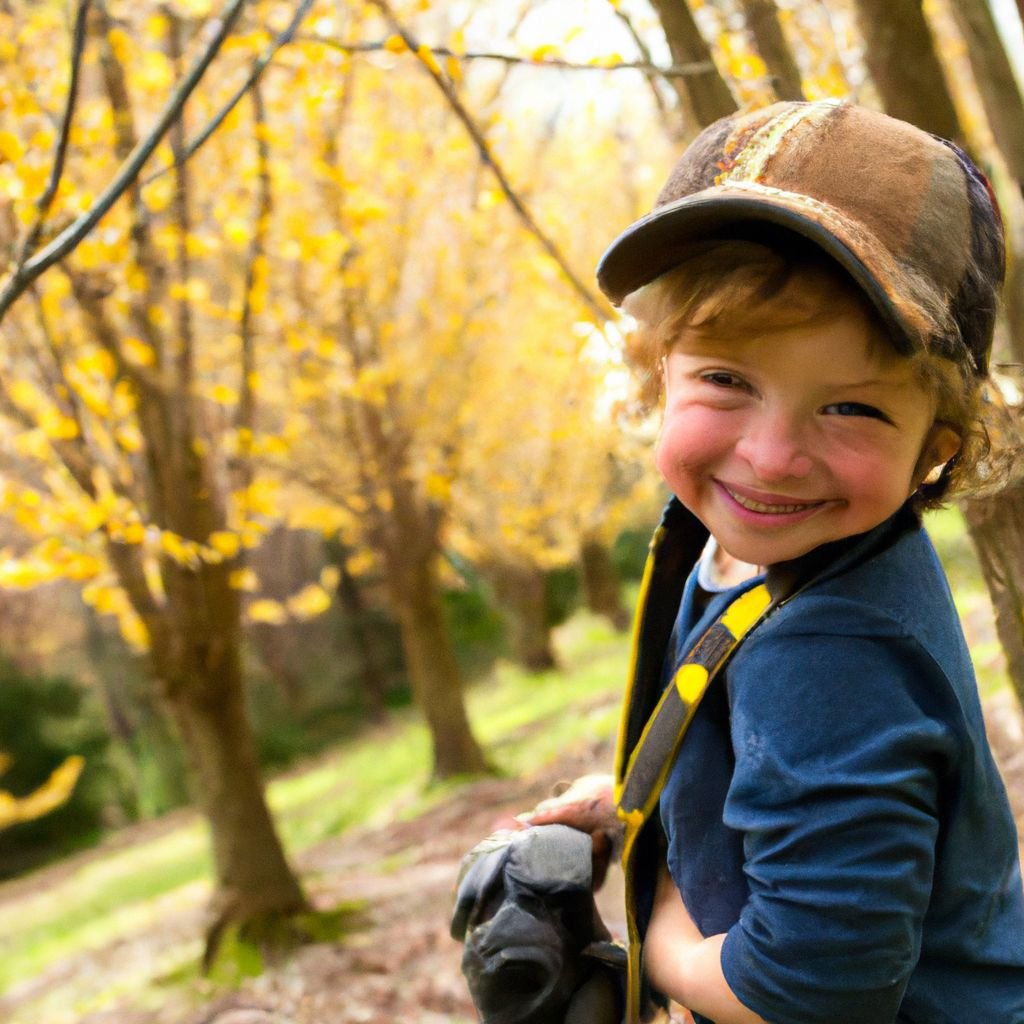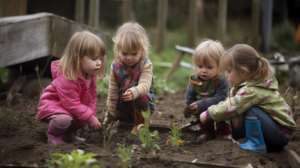Nature play is a crucial aspect of a child’s development. It provides numerous benefits, including cognitive, social, and emotional growth. By creating an outdoor learning environment and engaging children in nature play, we can foster their curiosity, promote risk-taking in a safe environment, and use nature as a valuable learning tool. Furthermore, nature play activities can be enjoyed all year round, with each season offering unique experiences and opportunities for growth. Here are the key takeaways from this article:
Key Takeaways
- Nature play supports cognitive development and enhances problem-solving skills.
- Outdoor learning environments should be designed to incorporate natural elements and loose parts for open-ended play.
- Engaging children in nature play encourages curiosity, exploration, and a sense of wonder.
- Promoting risk-taking in a safe environment helps children develop resilience and self-confidence.
- Using nature as a learning tool allows children to connect with the natural world and develop a sense of environmental stewardship.
Why Nature Play is Important for Children’s Development

Benefits of Nature Play
Nature play is not just about having fun outdoors, it also has numerous benefits for children’s development. Outdoor play allows children to engage with the natural world, fostering a sense of wonder and curiosity. It provides opportunities for physical activity and exercise, helping children develop their gross motor skills and coordination. Additionally, nature play promotes creativity and imagination, as children are encouraged to explore and interact with their surroundings.
How Nature Play Supports Cognitive Development
Nature play provides a rich and stimulating environment that supports children’s cognitive development in various ways. Exploration of the natural world allows children to engage their senses and make observations, which enhances their critical thinking and problem-solving skills. Through activities like building forts or creating nature art, children develop their creativity and imagination. They learn to think outside the box and come up with innovative solutions. Additionally, nature play promotes scientific thinking as children explore cause and effect relationships, make predictions, and test their hypotheses.
Social and Emotional Benefits of Nature Play
Nature play not only provides children with physical activity and fresh air, but it also has numerous social and emotional benefits. Connecting with nature can help children develop a sense of empathy and compassion towards living things. By observing and interacting with plants and animals, children learn to appreciate the beauty and diversity of the natural world.
Engaging in nature play also promotes social interaction and cooperation among children. Whether they are building a fort together or exploring a nature trail, children learn to work together, communicate, and solve problems as a team.
In addition, nature play can have a positive impact on children’s mental and emotional well-being. Spending time in nature has been shown to reduce stress, anxiety, and symptoms of attention deficit hyperactivity disorder (ADHD). It provides a calming and peaceful environment where children can relax, recharge, and improve their overall mood.
To maximize the social and emotional benefits of nature play, it is important to provide children with opportunities for unstructured play in natural settings. This allows them to explore, discover, and create their own experiences, fostering a sense of independence and self-confidence.
Creating an Outdoor Learning Environment

Designing a Natural Playscape
When designing a natural playscape, it’s important to create a space that encourages exploration and imagination. Natural elements such as rocks, logs, and plants can be used to create different play areas and obstacles. These elements not only provide opportunities for physical activity but also stimulate creativity and problem-solving skills. Children can use their imagination to transform a fallen log into a pirate ship or a pile of rocks into a castle.
In addition to natural elements, consider incorporating loose parts into the playscape. Loose parts are materials that can be moved, manipulated, and combined in various ways. They can include items like sticks, branches, fabric scraps, and buckets. By providing loose parts, children have the freedom to create their own play experiences and engage in open-ended play.
To enhance the sensory experience in the playscape, include elements that engage the senses. Water features such as a small stream or a water table can provide opportunities for sensory exploration and water play. Children can splash, pour, and experiment with water, developing their fine motor skills and understanding of cause and effect.
A sandbox or a designated digging area can also be included to provide tactile experiences. Children can dig, build, and mold sand, enhancing their sensory development and creativity.
Remember, when designing a natural playscape, safety should always be a priority. Ensure that the playscape is age-appropriate and free from hazards. Regularly inspect the playscape for any potential dangers and make necessary repairs or modifications.
Incorporating Loose Parts for Open-Ended Play
Incorporating loose parts into outdoor play spaces can greatly enhance children’s creativity and imagination. Loose parts are open-ended materials that can be moved, manipulated, and combined in various ways. They can include items like sticks, stones, pinecones, shells, and fabric scraps. By providing children with a variety of loose parts, they are encouraged to explore and experiment, creating their own unique play experiences. Loose parts play allows children to engage in self-directed and self-initiated play, where they have the freedom to make choices and use their imagination. It also promotes problem-solving skills, critical thinking, and collaboration as children work together to build and create with the loose parts.
Creating Sensory Experiences in Nature
Creating sensory experiences in nature is a wonderful way to engage children’s senses and enhance their learning. By providing opportunities for children to touch, smell, hear, and see the natural world around them, we can stimulate their curiosity and foster a deeper connection with nature. Sensory play is not only fun, but it also has numerous benefits for children’s development. It helps to develop their sensory processing skills, fine motor skills, and language skills. It also promotes creativity, problem-solving, and social interaction.
Engaging Children in Nature Play

Encouraging Curiosity and Exploration
Encouraging children to be curious and explore the natural world around them is a fundamental aspect of nature play. Curiosity is the driving force behind learning and discovery, and when children are given the freedom to explore, they develop a sense of wonder and awe for the world. By providing opportunities for exploration, we can ignite their natural curiosity and foster a lifelong love for nature.
One way to encourage curiosity is by creating a nature scavenger hunt. This activity not only engages children in active exploration but also helps them develop their observation skills. They can search for different types of leaves, rocks, or insects, and learn about the unique characteristics of each item they find. This hands-on experience allows them to connect with nature on a deeper level and sparks their curiosity to learn more.
Another way to foster curiosity is by encouraging children to ask questions. When they encounter something new or interesting in nature, we can prompt them to think critically and ask why or how things work. By encouraging their curiosity, we empower them to seek answers and develop their problem-solving skills.
Promoting Risk-Taking in a Safe Environment
Encouraging children to take risks in a safe environment is an essential part of their development. Risk-taking allows children to push their boundaries, build confidence, and develop problem-solving skills. It’s important to create a space where children feel comfortable exploring and trying new things.
One way to promote risk-taking is by providing age-appropriate challenges. These challenges can include climbing structures, balancing beams, or even a simple obstacle course. By engaging in these activities, children learn to assess risks, make decisions, and overcome obstacles.
Another important aspect of promoting risk-taking is supervision. While it’s important to allow children to take risks, it’s equally important to ensure their safety. Supervising their play allows you to step in if necessary and provide guidance when needed.
In addition to physical challenges, it’s also important to encourage children to take intellectual and social risks. This can include trying new activities, speaking up in group discussions, or taking on leadership roles. By encouraging these types of risks, children develop important skills such as creativity, communication, and collaboration.
Remember, promoting risk-taking in a safe environment is about finding the right balance between allowing children to explore and keeping them safe. By providing age-appropriate challenges, supervision, and opportunities for intellectual and social risks, you can help children develop important life skills while fostering a love for nature.
Using Nature as a Learning Tool
Nature is a powerful teacher, providing endless opportunities for children to learn and grow. By using nature as a learning tool, children can develop a deep connection with the natural world while also building important skills and knowledge. Exploring the outdoors allows children to engage their senses, observe patterns and changes in the environment, and make connections between the natural world and their own lives. Whether it’s identifying different types of plants and animals, studying the life cycle of a butterfly, or investigating the properties of water, nature provides a rich and diverse curriculum for learning.
Nature Play Activities for Every Season

Spring: Gardening and Planting
Spring is the perfect time to get children involved in gardening and planting. Gardening provides a hands-on learning experience that allows children to connect with nature and understand the process of how plants grow. It teaches them about responsibility, patience, and the importance of taking care of living things. Planting seeds and watching them sprout into beautiful flowers or delicious vegetables is a rewarding experience that can foster a sense of accomplishment and pride.
To make gardening and planting even more engaging, here are some ideas:
- Create a sensory garden: Include plants with different textures, colors, and scents to stimulate the senses.
- Start a vegetable patch: Let children choose their favorite vegetables to grow and take care of.
- Explore the world of pollinators: Teach children about the important role of bees and butterflies in pollination.
Remember, gardening and planting not only provide educational benefits but also promote a love for nature and a sense of environmental stewardship.
Summer: Water Play and Nature Scavenger Hunts
Summer is the perfect time to engage children in water play and nature scavenger hunts. Water play provides a refreshing and sensory experience for children, allowing them to explore the properties of water and develop their fine motor skills. Whether it’s splashing in a pool, running through sprinklers, or playing with water toys, children can have hours of fun while staying cool.
Nature scavenger hunts are a great way to encourage children to explore the natural world around them. By creating a list of items to find, such as leaves, rocks, or flowers, children can develop their observation skills and learn about different plants and animals. They can also learn about the concept of biodiversity and the importance of preserving nature.
Here are some ideas for water play and nature scavenger hunts:
- Set up a water table with various containers and utensils for pouring and scooping water.
- Create a DIY sprinkler using a plastic bottle with holes punched in it.
- Go on a nature walk and collect items like pinecones, feathers, and shells.
- Use a magnifying glass to examine insects and other small creatures.
Remember to always supervise children during water play and ensure they are in a safe environment. Encourage them to ask questions and explore their surroundings. Summer is a wonderful time to connect with nature and create lasting memories.
Fall: Leaf Crafts and Nature Art
Fall is a wonderful time to engage children in leaf crafts and nature art. The changing colors of the leaves provide a beautiful backdrop for creative projects. Leaf crafts allow children to explore the textures, shapes, and colors of different leaves, while also developing their fine motor skills. Nature art encourages children to use their imagination and creativity to create unique pieces using natural materials.
Here are some ideas for leaf crafts and nature art activities:
- Leaf rubbings: Place a leaf under a piece of paper and use a crayon or pencil to rub over the leaf, revealing its shape and texture.
- Leaf collages: Collect a variety of leaves and arrange them on a piece of paper to create a collage. Use glue to secure the leaves in place.
- Leaf prints: Dip leaves in paint and press them onto paper to create leaf prints.
Remember to encourage children to observe and discuss the different shapes, colors, and textures of the leaves they are working with. This not only enhances their artistic skills but also promotes their observation and descriptive language abilities.
Tip: Provide a variety of leaves, including different sizes, shapes, and colors, to inspire creativity and exploration.
Winter: Snow Play and Animal Tracking
Winter is a magical time for outdoor play, especially when there is snow on the ground. Snow play provides children with a unique sensory experience and opportunities for imaginative play. Building snowmen, having snowball fights, and creating snow angels are all fun activities that promote physical development and coordination. Additionally, animal tracking is a great way to engage children in nature during the winter months. By identifying animal footprints in the snow, children can learn about different animal species and their behaviors. It’s like being a detective in the wilderness!
Check out these nature play activities for every season! Whether it’s spring, summer, fall, or winter, there are plenty of fun and educational activities that kids can enjoy outdoors. From scavenger hunts and nature walks to building forts and collecting leaves, there’s something for everyone. So why not get outside and explore the wonders of nature with your children? Visit Ms. Kerri’s Story Telling Corner to find more exciting ideas and inspiration for nature play. Let’s create unforgettable memories and foster a love for the great outdoors!
In conclusion
Nature play is a wonderful way to engage children in outdoor learning all year round. By providing opportunities for exploration, creativity, and problem-solving, we can help children develop important skills while fostering a love for nature. Whether it’s building forts, going on nature walks, or simply observing the wonders of the natural world, there are endless possibilities for outdoor learning. So, let’s encourage our children to put down their screens and embrace the beauty of the outdoors. Together, we can create a generation of nature lovers and lifelong learners.
Frequently Asked Questions
Why is nature play important for children?
Nature play is important for children as it allows them to connect with the natural world, develop their creativity and imagination, and enhance their physical and mental well-being.
What are the benefits of nature play?
Nature play has numerous benefits including improved cognitive skills, increased physical activity, enhanced problem-solving abilities, reduced stress and anxiety, and improved social skills.
How does nature play support cognitive development?
Nature play stimulates children’s senses and encourages them to explore and engage with their surroundings. This helps develop their cognitive skills such as problem-solving, critical thinking, and decision-making.
What are the social and emotional benefits of nature play?
Nature play provides opportunities for children to develop social skills such as cooperation, communication, and empathy. It also promotes emotional well-being by reducing stress, improving mood, and fostering a sense of connection with nature.
How can I create an outdoor learning environment for children?
To create an outdoor learning environment, you can design a natural playscape with elements like rocks, logs, and plants. Incorporate loose parts for open-ended play and provide sensory experiences in nature through activities like mud play or sensory gardens.
How can I encourage curiosity and exploration in nature play?
To encourage curiosity and exploration in nature play, allow children to freely explore their surroundings, ask questions, and investigate natural materials. Encourage them to observe and interact with plants, animals, and natural phenomena.


Ms. Kerri’s Corner provides a exciting virtual space for preschool learning. Through a variety of engaging activities, she exposes young minds to early math, literacy, science and social-emotional skills in a developmentally appropriate way. Centers for blocks, art, books and music allow children to explore hands-on learning at their own pace. Guided lessons subtly introduce number sense, letter sounds and narrative thinking. Careful observation gives insight into each child’s progress across domains. Viewers are also invited to participate, reinforcing that their ideas are valued. By making learning fun yet purposeful, Ms. Kerri lays the groundwork for future academic success while fostering creativity and imagination. Her program offers preschoolers valuable screen-based learning experiences.






